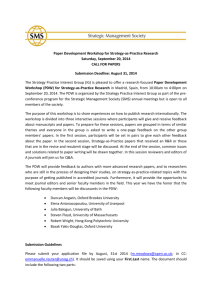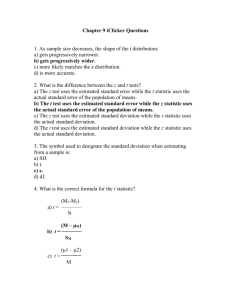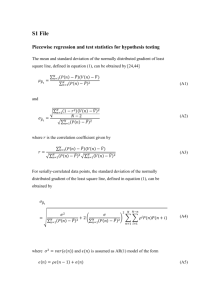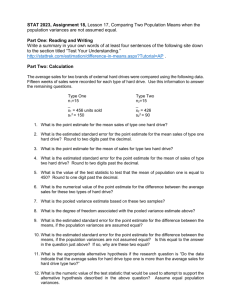tests of hypotheses: inferences based upon two groups
advertisement
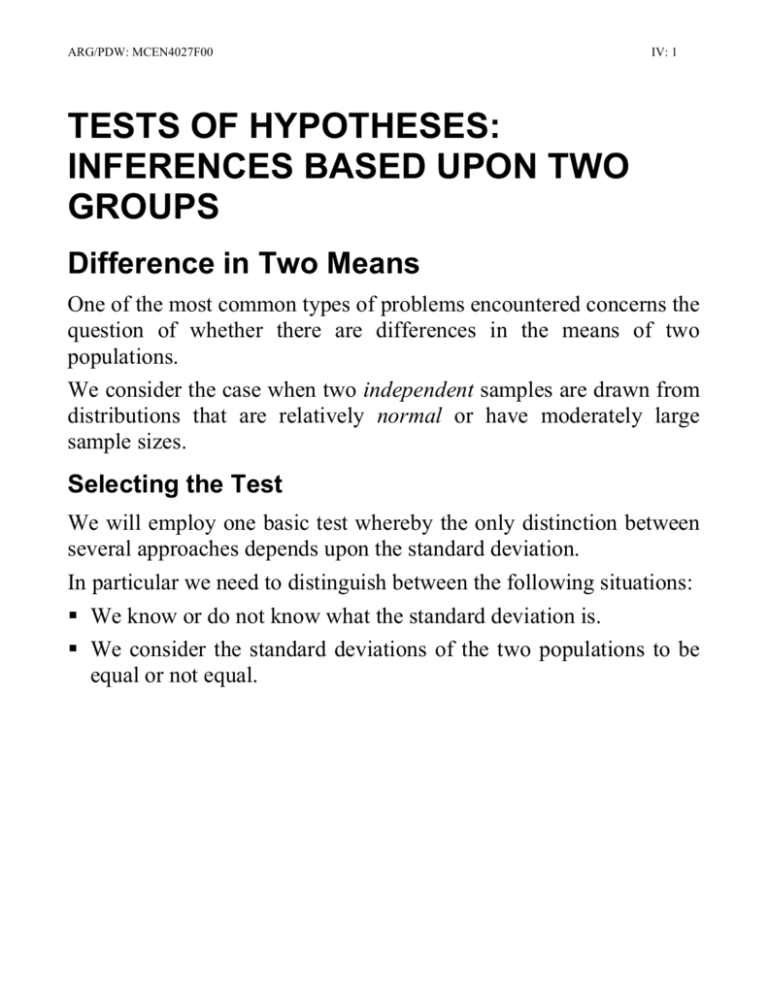
ARG/PDW: MCEN4027F00
IV: 1
TESTS OF HYPOTHESES:
INFERENCES BASED UPON TWO
GROUPS
Difference in Two Means
One of the most common types of problems encountered concerns the
question of whether there are differences in the means of two
populations.
We consider the case when two independent samples are drawn from
distributions that are relatively normal or have moderately large
sample sizes.
Selecting the Test
We will employ one basic test whereby the only distinction between
several approaches depends upon the standard deviation.
In particular we need to distinguish between the following situations:
We know or do not know what the standard deviation is.
We consider the standard deviations of the two populations to be
equal or not equal.
ARG/PDW: MCEN4027F00
IV: 2
The first question establishes the limit value and the second provides
the test statistic.
If we know the standard deviation, the limit is a z-value and we
have a z-test.
If we do not know the population standard deviation, then we
must estimate it from the samples.
We then use a t-limit and have a t-test.
If the standard deviation is to be the same for both samples, then
the z-test is somewhat simplified, as there is only one value of .
For a t-test the variances must be evaluated to determine
whether they are equal (F-test).
If the F-test shows no difference, then the variances can be
averaged (pooled variance) – a single estimate of .
If the variances are not the same, then a different
calculation scheme is employed.
ARG/PDW: MCEN4027F00
IV: 3
Sampling Distributions
The Student’s t Distribution
The student’s t distribution is given by
x
t
s n
where x and s are the sample mean and standard deviation, is the
population mean and n is the sample size.
The student’s t distribution has = n - 1 degrees of freedom.
The critical values for the t distribution are given in terms of and
and , i.e. t,, and are tabulated in standard statistical tables.
Here is the level of significance of the one-tailed test, i.e.
the probability that a given value of t would be obtained by
chance.
ARG/PDW: MCEN4027F00
IV: 4
The F Distribution
The F distribution is given by
F
s12
s22
where s1 and s2 are the means from two samples, 1 and 2.
The F distribution has 1 = n1 - 1 degrees of freedom for the
numerator and 2 = n2 - 1 degrees of freedom for the
denominator.
The critical values for the F distribution are given in terms of
and , 1 and 2, i.e. F,1,2 and are tabulated in standard
statistical tables.
ARG/PDW: MCEN4027F00
IV: 5
The Hypothesis
The appropriate hypothesis to be tested at a significance level is:
There is no difference between the population means (1 = 2)
where 1 and 2 represent the means of the first and second
populations, respectively.
The appropriate alternative hypothesis is:
There is a difference between the population means:
For a two-tailed test, 1 2.
For a one-tailed test, 1 < 2 or 1 > 2.
ARG/PDW: MCEN4027F00
IV: 6
Example 1
An experiment was conducted in which two groups of samples were
subjected to heat treatments at two different temperatures for the
same length of time. The effect of the heat treatments was
determined by hardness measurements. The results are summarized
in the following table.
Experimental Results
Heat Treatment
Temperature (C)
Rockwell Hardness
(RB)
Mean
Standard
Deviation
T1
82, 76, 77, 84, 79, 86
80.7
3.98
T2
68,73, 77, 78, 70, 80
74.3
4.76
1. Can the variances be pooled?
Use the F-test with:
Ho: 12 22 ; H1: 12 22
Use sample variances to estimate population values:
F
s12
s22
15.9
0.700
22.7
Critical values of F-statistic at = 0.05 with df = 1 = 2 = 5:
F0.025(1, 2) = F (5, 5) = 0.14; F0.975((1, 2) = F (5, 5) = 7.15
Decision: Since the test statistic is within the limit, we accept the
null hypothesis and can therefore pool the variances.
ARG/PDW: MCEN4027F00
IV: 7
2. Compare the sample means.
Use the t-test with:
Ho: 1 = 2; H1: 1 2
Calculate pooled variance:
s 2p
n1 1s12 n2 1s22
19.3
n1 n2 2
Calculate test statistic:
X1 X 2
t
2.499
1
1
sp
n1 n2
Critical value of t-statistic at = 0.05 with df = n1 + n2 –2 = 10:
Upper limit: t1-/2 = t0.975 = 2.228
Lower limit: t/2 = t0.025 = -2.228
Decision: Since the test statistic is greater than the limiting
value, we reject the null hypothesis and conclude that
there is a significant difference in hardness due to the
two heat treatments.
ARG/PDW: MCEN4027F00
IV: 8
Example 2A
An experiment was conducted in which a group of samples was
subjected to a specific heat treatment. The effect of the heat
treatment was determined by hardness measurements, and the
concern was whether the results conformed to the expected (i.e.,
“theoretical”) hardness value of RB 80. The results are summarized
in the following table.
Experimental Results
Heat Treatment
Temperature (C)
Rockwell Hardness
(RB)
Mean
Standard
Deviation
T1
68,73, 77, 78, 70, 80
74.3
4.76
In general, our approach is governed by whether or not the population
or theoretical standard deviation is known. If it is not (as in this
case), we must estimate from the sample variance.
ARG/PDW: MCEN4027F00
IV: 9
Compare the population means.
Use the t-test with:
Ho: = theoretical; H1: theoretical
Calculate the test statistic (note that the formulation of the test
statistic is based upon a population assumption; consequently, n2
is very large () and only n1 = n appears in the calculation:
t
X theo 74.3 80
2.93
s n
4.76 6
Critical value of the t-statistic at = 0.05 with df = n–1 = 5:
Upper limit: t1-/2 = t0.975 = 2.571
Lower limit: t/2 = t0.025 = -2.571
Decision: Since the test statistic is less than the limit (i.e.,
outside of the range), we reject the null hypothesis
and conclude that there is a difference in hardness
between the sample and “theoretical” value.
ARG/PDW: MCEN4027F00
IV: 10
Example 2B
The capacity of insulation to block the flow of heat is customarily
measured by its R value. To test a manufacturer’s claim that a new
insulating material possesses an R value of 3.8 per inch of thickness
and therefore is suitable for meeting the most stringent building
codes, 5 test measurements will be taken, each on a specimen of a
different production batch. Although it will be assumed that the
measurement process is normally distributed, the newness of the
product makes it likely that a good estimate of the variance is
lacking. If the five measurements provide values of 3.9, 3.8, 4.0, 4.1,
and 4.2, should the new insulation be placed on the approved list?
Solution
1. Hypothesis Test
Ho: = 3.8
Ha: 3.8
2. Level of Significance
Assuming there is no reason to demand an especially
stringent level of significance, let = 0.05.
3. Test Statistic
Normality allows use of the t test with 5-1 = 4 degrees of
freedom. The test statistic is given by
t
X 3 .8
S n
4. Sample Size: n = 5
5. Critical Region: Obtain from tables.
ARG/PDW: MCEN4027F00
IV: 11
Since t/2,n-1 = t0.025,4 = 2.776,
the resulting critical region is
C = {t: t -2.776 or t -2.776}
6. Sample Value
Suppose the 5 measurements are 3.9, 3.8, 4.0, 4.1, 4.2;
then x = 4.0 and s = 0.158. Consequently, the sample value
of the test statistic is
t
X 3.8 4.0 3.8
2.830
S 5
0.158 5
7. Decision: Reject Ho since t > 2.776.
Example 3
An experiment was conducted in which a group of samples was
subjected to a specific heat treatment. Since the effect of the heat
treatment was determined by hardness measurements (the response
variable), advantage can be made of the fact that this measurement is
nondestructive. The results are summarized in the following table for
hardness test values on six different specimens before and after the
treatment (one hardness-test for each condition).
Experimental Results
Heat Treatment
at Temperature
T (C)
Rockwell Hardness
(RB)
Before
82, 76, 77, 84, 79, 86
After
70, 80, 78, 77, 68, 73
Difference Difference
Mean
Standard
Deviation
6.33
7.20
ARG/PDW: MCEN4027F00
IV: 12
When each value in one sample has a clear counterpart in the second
sample or is related to a specific value in the second sample, we can
utilize an approach to determine whether there is a difference
between the paired values that is more sensitive than those previously
described.
If the differences (like the values) are close to being normally
distributed, then we can calculate the mean and standard
deviation of the differences and apply a t-test.
Our assumption is that if there is no real overall difference, then
the average of the differences should be zero.
Compare the population means.
Use the t-test with:
Ho: difference = d = 0; H1: difference 0
Calculate test statistic:
t
d
s
n
6.33
2.15
7.20 6
Critical value of the t-statistic at = 0.05 with df = n–1 = 5:
Upper limit: t1-/2 = t0.975 = 2.571
Lower limit: t/2 = t0.025 = -2.571
Decision: Since the test statistic does not exceed the limit, we
accept the null hypothesis and conclude that there is
no difference in hardness due to the heat treatment.
ARG/PDW: MCEN4027F00
IV: 13
EXCEL Statistical Package
t-Test: Paired Two Sample for
Means
Mean
Variance
Observations
Pearson Correlation
Hypothesized Mean Difference
df
t Stat
P(T<=t) one-tail
t Critical one-tail
P(T<=t) two-tail
t Critical two-tail
Variable 1
80.66666667
15.86666667
6
-0.35153783
0
5
2.154089791
0.041905297
2.015049176
0.083810593
2.570577635
Variable 2
74.33333333
22.66666667
6
